April 2010
Welcome to this issue of the Hardwood Tree Improvement and Regeneration Center E-newsletter. The HTIRC is committed to enhancing the productivity and quality of Central Hardwood Region trees and forests for the economic and environmental benefits they provide. Scientists at the HTIRC are using conventional tree improvement breeding as well as molecular and genetic technologies to improve the wood quality, growth characteristics, and insect and disease resistance of trees like black walnut, black cherry, red and white oaks, butternut and American chestnut.
Research in tissue culture, tree nursery practices, tree plantation establishment and management, and Central Hardwoods silvicultural systems is aimed at increasing the regeneration
success rate for high quality hardwood trees and forests. Some interesting and unusual research areas include examining the potential for propagating trees with “figured” wood: birds-eye maple or curly walnut; and breeding trees that will be an economical source of bio-fuels.
Twice per year, we will attempt to provide interesting and useful information on Central Hardwood trees and forests, as well as sources for additional information and assistance.
Please pass this newsletter along to others who may enjoy or benefit from the information provided. If you would like a closer look at the HTIRC, please visit our web site at: http://www.htirc.org
Developing Ash Species with Resistances to the Emerald Ash Borer
By Paula Pijut
Ash timber is valued for applications requiring strong, hard wood (Fig. 1). Green ash (Fraxinus pennsylvanica) wood is used for general solid wood products such as, crates, boxes, tool handles, furniture, oars, canoe paddles, and for fiber in the manufacture of high-grade paper. White ash (F. americana) wood is used for baseball bats, tool handles, furniture, doors, flooring, and cabinets. Black ash (F. nigra) wood is used for interior finish, furniture, barrel hoops, snowshoe frames, canoe ribs, and Native Americans require this species for the art of basketry. Ash woodlands are important in supporting a rich bird community by providing cover and nesting sites for various bird species. Ash trees also have an important role in the urban landscape by sequestering pollutants, conserving energy by providing shade, and providing shelter for urban fauna.
An aggressive exotic wood-boring beetle, the emerald ash borer (EAB) [Agrilus planipennis], is attacking and killing all ash trees in North America (Fig. 2). First identified in Michigan in 2002, the EAB has since been detected in Ontario, Ohio, Indiana, Illinois, Maryland, Pennsylvania, West Virginia, Wisconsin, Missouri, Virginia, Minnesota, and New York (Fig. 3). The adult beetles (one- or two-year life cycle) begin emerging in mid-May and females usually begin laying eggs about 2 wk after emergence. After the eggs hatch, the tiny larvae (Fig. 4) bore through the bark and into the cambium region (area between the bark and wood) where nutrient levels are high. The larvae feed under the bark, eventually reach 2.5- to 3-cm in length, form galleries (passage way made by tunneling) (Fig. 5), and most EAB larvae overwinter in a small chamber in the outer bark or in the outer inch of wood. Pupation occurs in spring with the next generation of adult beetles emerging in May to June and the life cycle repeats (http://www.emeraldashborer.info/). There are no known resistance genes in native species of ash, nor any means of complete eradication at this time, and the EAB is continuing its spread through North America’s forests and urban areas resulting in significant economic loss and environmental damage (Fig. 6). The EAB has cost municipalities, property owners, nursery operators, and forest products industries tens of millions of dollars, and the ecological costs are enormous.
A research team at the Hardwood Tree Improvement and Regeneration Center, led by plant physiologist Paula M. Pijut, are using plant tissue culture and gene insertion techniques to develop ash species with resistance to the EAB. Bacillus thuringiensis (Bt), a naturally occurring bacterium, has widespread use in controlling forest pests in the United States and Canada because of its environmentally benign nature. To date, the Pijut lab team has developed plant tissue culture and genetic technology methods to insert a Bt toxin gene into green, white, or black ash in order to impart resistance to the EAB. By manipulating the plant tissue culture medium with different plant growth regulators and controlling environmental lab conditions, the researchers are able to induce ash shoots to be produced on hypocotyls (Fig.7A) cultured in a Petri dish. With additional experimental manipulations, the group is then able to induce these shoots to elongate (Fig. 7B), form roots (Fig. 7C), and then these tissue culture plantlets can be acclimatized to the greenhouse (Fig. 7D). This method of plant regeneration from hypocotyls is then used in a process to genetically insert the Bt toxin gene and produce ash plantlets containing this new gene. Research studies are currently underway to begin producing plantlets containing the Bt gene and confirm resistance to the EAB. This is a major step towards developing ash trees with resistance to the EAB. For reprints of these scientific journal publications see: http://www.agriculture.purdue.edu/fnr/HTIRC/publications/research.html.
Additional information on ash and EAB in the United States and Canada is available at the following websites:
http://nrs.fs.fed.us/disturbance/invasive_species/eab/
http://www.emeraldashborer.info/index.cfm
http://extension.entm.purdue.edu/EAB/
http://www.na.fs.fed.us/fhp/eab/
http://www.aphis.usda.gov/plant_health/plant_pest_info/emerald_ash_b/background.shtml
http://www.inspection.gc.ca/english/plaveg/pestrava/agrpla/agrplae.shtml

Figure 1. Ash flooring (Columbia Flooring; www.HardwoodInfo.com)

Figure 2. Emerald ash borer adult (David Cappaert, Michigan State University, Bugwood.org)
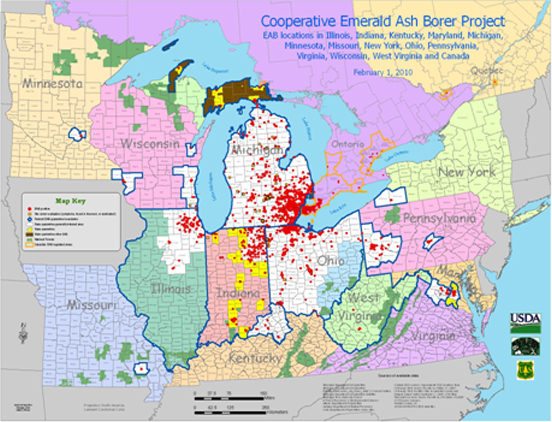
Figure 3. Locations of the emerald ash borer as of February 1, 2010 (www.emeraldashborer.info).
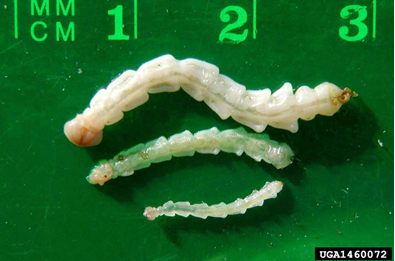
Figure 4. Emerald ash borer larval stages (David Cappaert, Michigan State University, Bugwood.org).
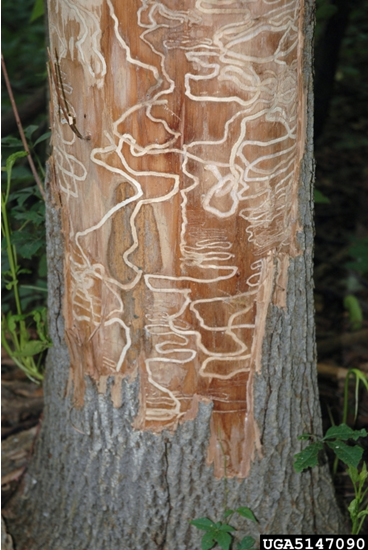
Figure 5. Emerald ash borer galleries (Art Wagner, USDA APHIS PPQ, Bugwood.org).

Figure 6. Emerald ash borer damage (David Cappaert, Michigan State University, Bugwood.org.
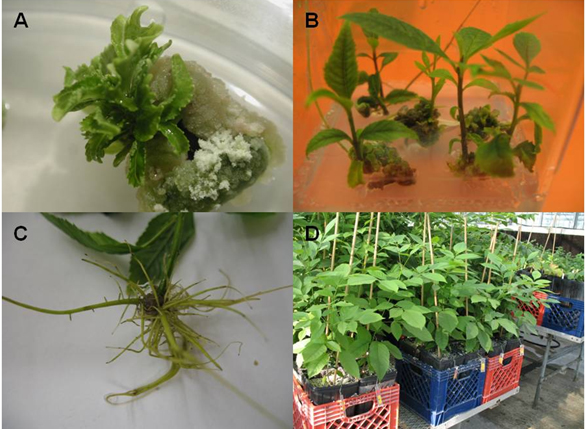
Figure 7. Plant regeneration from green ash hypocotyls (Du and Pijut 2008).
Studying the Growth of Black Walnut – a Leaf Area Approach
By Jake Dyer and Mike R. Saunders
The relationship between leaf area and growth of trees is important in understanding forest productivity (carbon and timber) and tradeoffs associated with various management practices. There have been many studies showing that the total surface area (expressed as meters squared) of leaves on a tree is closely related to tree growth and subsequent dynamics. Thus, it would be expected that any type of management that influences how the tree holds leaf area, such as density management or pruning, may potentially influence the growth of these trees. Most studies have focused on conifer species, but it is largely assumed that hardwoods exhibit similar relationships. We set out to confirm the relationship between leaf area and growth of well-maintained plantation black walnut (Juglans nigra L.). The study consisted of randomly selecting twelve black walnut during a thinning operation within a 28-year-old plantation owned by ArborAmerica, Inc. near West Lafayette, Indiana. Diameter, height and crown dimensions of each tree were recorded; trees were then felled and processed according to standard allometric leaf area-growth efficiency methods. Specifically, these methods consisted of randomly selecting branches from throughout the crown of the tree across the range of branch diameter sizes (measured at the branch collar). All leaves from the selected branches were then carefully removed and sorted back in the lab for subsequent leaf area analysis. Additionally, we collected stem cross sections every one meter up the length of the bole of the tree to determine recent growth (past five years) vertically through the stem, and relate that to the total leaf area of the tree. Not surprisingly, we found that branch-level leaf area increased linearly with basal branch diameter. Specific leaf area, the ratio of leaf area to leaf weight, or essentially a measure of leaf thinness, ranged from 125 to 180 cm²∙g-1. Growth efficiency, or the volume of wood produced per unit of leaf area, ranged from 2 to 3 dm3∙m-2. These parameters help us better understand how efficiently trees produce wood in plantation settings and have the potential to help design plantations more precisely to optimize wood production. We plan to continue to explore leaf area-growth relationships of other deciduous hardwood species native to the Central Hardwood region, both in plantation and native stand settings. This research will be presented at the 17th Central Hardwood Forest Conference in Lexington, KY this April.


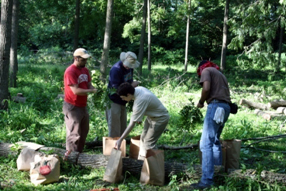

Samples were processed in mid-July from the site (top left). This included collecting all branch diameters (top right) and stripping foliage from a sample of branches on each tree (bottom left). Lastly, foliage samples were sorted (bottom right), with up to 50 leaves per branch sub-sampled for leaf area.
Epicormic Branching in White Oak
By Andy Meier, Mike R. Saunders, and Charles H. Michler
White oak has long been known to foresters and the lumber industry to be particularly susceptible to epicormic branching (Fig. 1), especially in response to increases in light. Release treatments intended to enhance the growth of potentially vauluable trees often exacerbate problems with epicormics. Though log volume may be greater in released trees, the value gained is often offset by decreases in log value from a higher number of larger epicormic branches.
Conventional wisdom holds that tree vigor and genetics are the most important factors controlling the formation of epicormic sprouts on trees released from competition. We are initiating a study to compare the influences of these two variables on the tendency of trees to form epicormic branches. We will be using two unthinned white oak plantations established by the Indiana Department of Natural Resources in 1983 from trees originating in Missouri, Illinois and Indiana. A number of different families are represented in these plantations, giving us the ability to correlate sprouting and growth responses to individual families.
For our test, we have selected a subset of families that were previously identified to produce high, medium, or low numbers of epicormic sprouts. We are taking initial measurements focusing on growth variables (such as diameter and height), while at the same time making exhaustive counts of branches present on trees prior to treatment (Fig. 2). We will then fully release the trees from competition, and, in order to reduce tree vigor in some trees, will remove a part of the live crown in a subset of individuals. Over a period of two growing seasons we will track changes in epicormic branching across treatments and assess the relative importance of genetics and vigor. Depending on funding, we plan to use a high-resolution log scanning system to quantify the actual population of internal epicormic structures across families; this will allow us to determine if some families are genetically predisposed to producing sprouts upon release because of a larger long-term population of epicormic structures.
We anticipate that we will find that there is genetic control of the number of initial epicormic buds in the tree, though vigor may play a significant role in the ability of the trees to shed already sprouted shoots. We also hope to use the information we gather to develop a rating system to estimate epicormic potential based on a quick estimation of the number and size of branches present, improving the process for selecting crop tree in the forest.

Figure 1 Epicormic branches on young white oak trees.
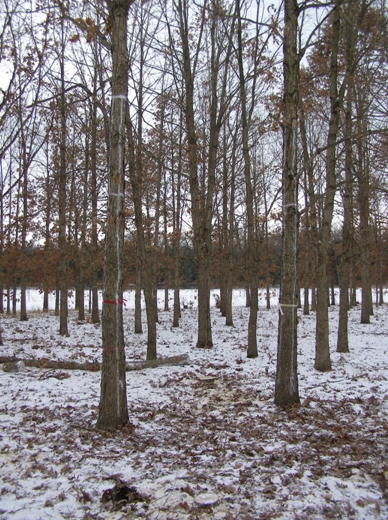
Figure 2 Study trees in the white oak epicormic experiment. The tree on the right will be removed and scanned.
HTIRC Tree Planting Continue in 2010
The Hardwood Tree Improvement and Regeneration Center is gearing up for the 2010 tree planting season. We have plans to plant over 10,000 seedlings at 6 different sites around the Central Hardwood Region. Plantings include:
Progeny tests for black walnut, black cherry, and butternut continuing our tree improvement work.
Silvicultural tests of hybrid butternut and American chestnut to learn more about the growth and management requirements for these trees.
Disease resistance screening tests for butternut and BC3F2 backcrossed chestnut to determine the extent of butternut canker and chestnut blight disease resistance, respectively, in these tree selections.
HTIRC partner organizations and several private landowners have been pivotal in making this research possible by providing planting sites and local assistance with maintenance and monitoring of the test plantings – thank you.
A Survey of Wood Borer Beetles on Private Forest Lands in Indiana
By Kapil Raje, Ph.D. Student, Lenny Farlee, Extension Forester, Hossam Abdel Moniem, Ph.D. Student, Jeffrey D. Holland, Ph.D., Virginia Ferris, Ph.D., Primary Investigators
In 2009, 19 private forest landowners within about 60 miles of Lafayette, Indiana volunteered to participate in a beetle survey on their property. One goal of this study was to examine the shifts in the overall community of these beetles across a variety of tree health conditions on landowner properties. We measured these conditions with the site indices, a measure of how tall a tree grows in 50 years, for two trees, white oak and tulip tree. As we predicted, there was a shift in the longhorned beetle communities to include more pests as the site index for white oak decreased. A result we did not predict was that the abundance and number of species of the non-pest species also increased with a decreasing white oak site index. This latter effect may be the result of less healthy trees having more dead wood associated with them, but we did not test this directly. Overall, the ratio of pests to non-pest individuals or species did not change over the site index gradient because both groups were influenced in a similar way. The same results were seen using the site index for tulip tree but the results were stronger with the white oak index.
By examining the species and site relationships encountered, we hope to develop a better understanding of how some of these species become forest pests. This project greatly advanced these efforts by providing fresh beetle specimens for molecular work from 58 species and 19 locations within west-central Indiana.
The Cerambycidae is a family of wood-boring beetles that is also known as longhorned beetles. It contains several devastating pest species. However, most species in this group are actually beneficial in recycling rotting wood and pollinating plants including hardwood trees. Of the 58 species of longhorned beetles captured at landowners’ woodlots, about one quarter to one third were considered pests of living trees or untreated lumber, while the rest were non-pest species that feed on rotting wood in forests. In addition, most of the pests found were minor pests that girdle twigs rather than species that bore into the bole of the tree. Some species that we call non-pests may actually be pests when they weaken dead inner wood in live trees. For example, the rustic borer is sometimes considered a pest because it often develops in the dead heartwood of still-living trees. The most serious pest commonly encountered was the painted hickory borer (Megacyllene caryae), which bores into the wood of stressed hickory trees and also bores in fresh hickory firewood and lumber. Landowners can avoid problems with this beetle by not having fresh hickory logs or firewood with bark still attached during spring and early summer. The beetle lays eggs under bark scales and the larvae bore through the bark and finally bore large holes through the sapwood and into the heartwood, severely impacting the quality of logs or firewood.
Another minor pest, the twig girdler (Anelaphus villosus), is interesting in that females girdle small twigs by chewing around them and then lay eggs beyond the wound thus ensuring that the tree will not be able to defend further against the larvae. The larvae develop while tunneling within the twig which later breaks off. The larvae then pupate in the soil. Twigs with smooth notches around the base, if not an obvious twig scar, and tunnels within, are signs of this or other twig girdlers. This insect serves as the host for at least two parasitic wasps and three insectivorous birds which are its natural means of control.
The pole borer (Neandra brunnea) attacks living trees which have exposed sapwood due to wounds and scars caused by mechanical bruises, improper pruning cavities, sunscald, winter injury, fire blight, collar rot, storm injury, and other borers. It rarely attacks trees that have healthy bark and are free from injuries. Its natural means of control are two parasitic wasps. The most important control measure is to prevent injury to trees because damage often begins in exposed dead wood. To mechanically remove this borer from trees, it is necessary to cut out all of the wood through which the borer galleries extend. The excavation should be cleaned completely of any infested decayed wood and filled with cement or other fill material.
In contrast, the non-pests species, like the banded longhorn beetle, provide us with many ecosystem services such as dead wood recycling, reducing forest fire fuel load, acting as food for wildlife, and pollinating flowering plants including many trees.
 |
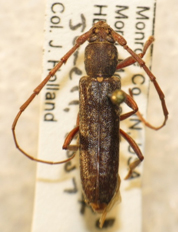 |
|---|---|
| Painted Hickory Borer (Megacyllene caryae) | Twig Pruner (Anelaphus villosus) |
 |
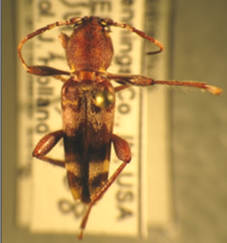 |
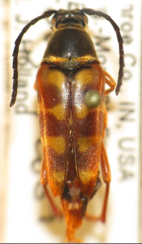 |
|---|---|---|
| Pole pruner (Neandra brunnea) |
Rustic borer (Xylotrechus colonus) |
Banded longhorn (Typocerus velutinus) |
All photos courtesy of Hossam Abdel Moniem
Have questions about tree planting? This series of publications can be viewed or downloaded free of charge. Planting and Care of Fine Hardwood Seedlings
Van Eck Scholarships available for graduate research with the HTIRC.
Ask the HTIRC: email Lenny Farlee with your tree planting and forest management questions and we’ll help you find the answers.
